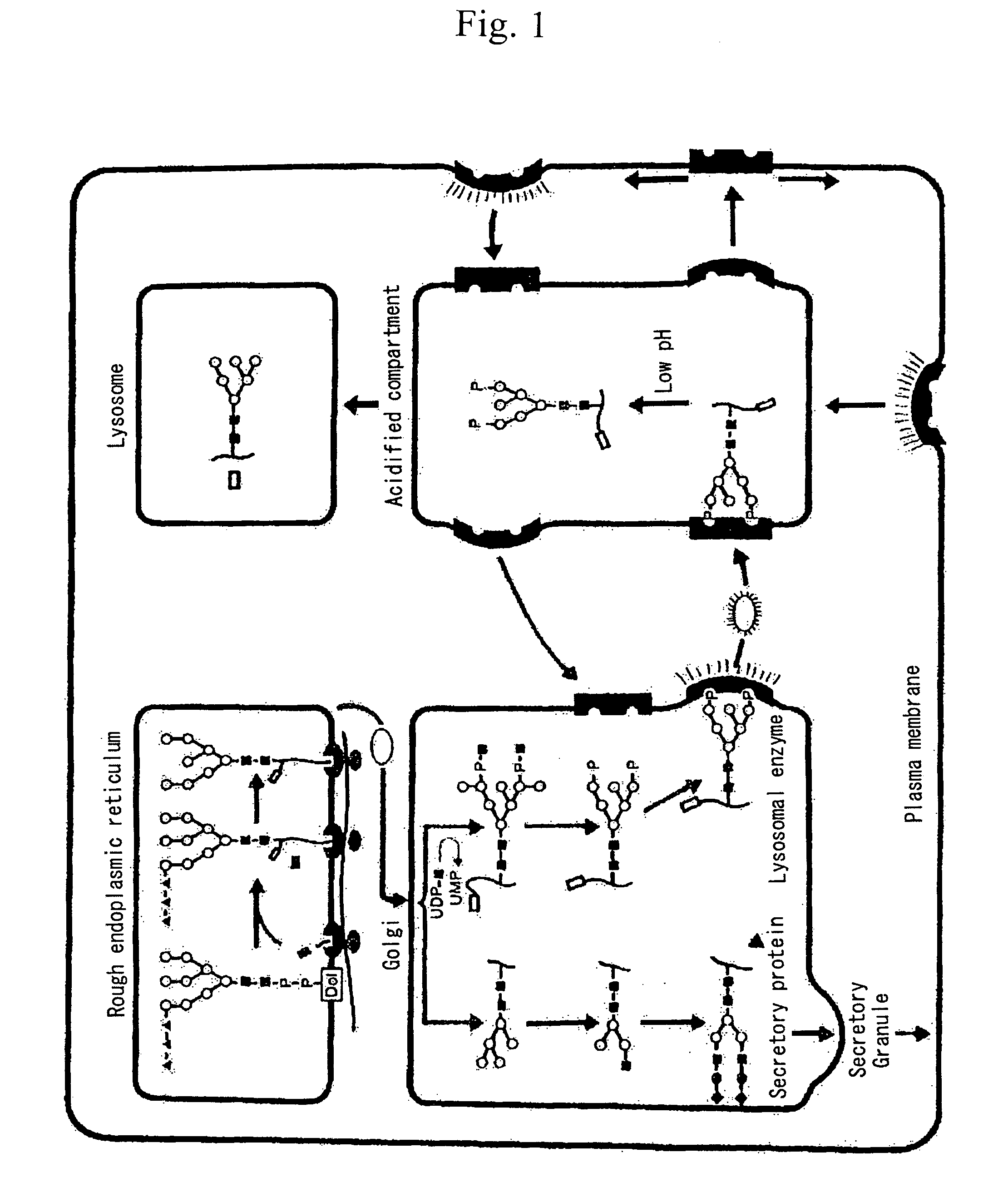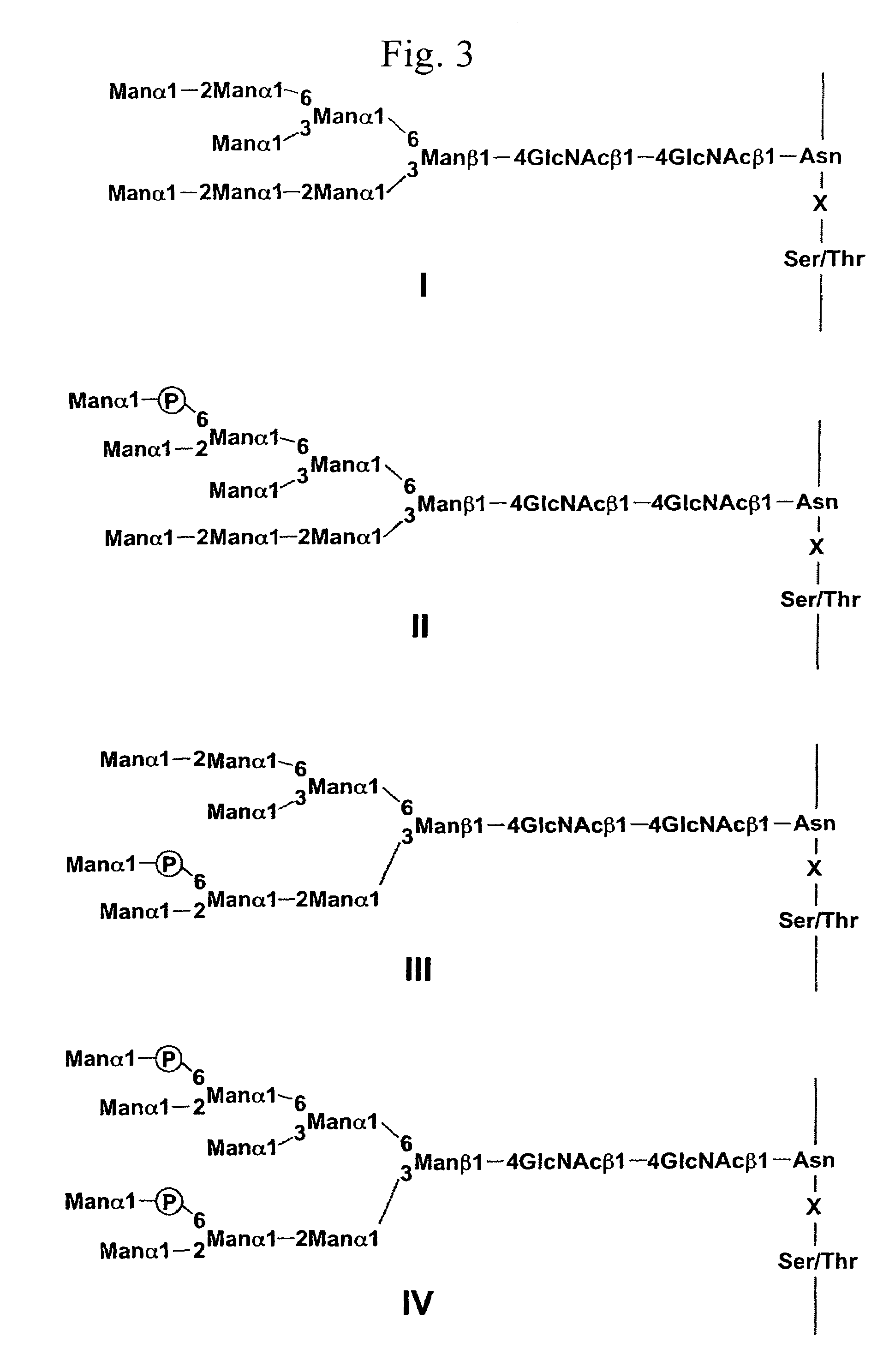Glycoprotein and process for producing the same
a glycoprotein and process technology, applied in the direction of transferases, peptide/protein ingredients, drug compositions, etc., can solve the problems of poor uptake by the target organ, unsuitable host yeast, and continued life, and achieve the effect of high purity
- Summary
- Abstract
- Description
- Claims
- Application Information
AI Technical Summary
Benefits of technology
Problems solved by technology
Method used
Image
Examples
example 1
Construction of the Sugar Chain Biosynthesis Double Mutant Yeast Containing Highly Phosphorylated Sugar Chains (Saccharomyces cerevisiae Δoch1 Δmnn1 Strain)
[0110]A cassette (HUH) in which Salmonella hisG gene was linked to both ends of URA3 gene by direct repeat was excised with BglII and BamHI from pNK51, which has been already reported (Alani et al., Genetics, 116, 541-545 (1987)), and was inserted into BamHI site in Escherichia coli plasmid pSP73. This plasmid was designated as pSP73-HUH.
[0111]The OCH1 gene is located on yeast chromosome 7, and the DNA nucleotide sequence of the OCH1 gene is registered in the GenBank database under the accession No. D11095 (Nakayama et al., EMBO J., 11, 2511-2519 (1992)). The previously constructed OCH1 gene-disrupting vector poch1::LEU2-1 (Nakayama et al., EMBO J., 11, 2511-2519 (1992)) was cleaved with SalI and HindIII to excise the region containing Δoch1::LEU2, and this was used to transform the highly phosphorylated sugar chain-producing yea...
example 2
Introduction of α-Galactosidase Gene into the Δoch1 Δmnn1 Double Disrupted Strain
[0115]The sequence of the human α-galactosidase gene is registered in the GenBank database under as NM000169 (Nucleic Acids Res. 17 (8), 3301-3302 (1989)). The previously reported pCXN2 (in Ishii et al., Hum. Genet. 89, 29-32 (1992)) was cleaved with EcoRI to excise the cDNA region for human α-galactosidase (−16 to +1290; SEQ ID No: 5). For the purpose of expression in yeast, it was then inserted into the EcoRI site of the yeast expression vector plasmid YEp352-GAP. The resulting plasmid was designated as YEp352-GAP-GLN. The cDNA region for human αgalactosidase including the promoter and terminator regions was then excised with BamHI from the plasmid, and inserted into the BamHI site of the integration vector pRS404. After cleaving this plasmid pRS-GLN-4 with Bst1107I, it was used to transform the S. cerevisiae HPY21 strain constructed in Example 1. The transformation was carried out by the lithium acet...
example 3
Purification of α-Galactosidase from Culture Supernatant of α-Galactosidase Gene-Introduced Strain, and Analysis of Sugar Chain Structure of the Purified Enzyme
[0120]The α-galactosidase gene-introduced strain HPY21G was cultured and a crude enzyme solution thereof prepared in the same manner as Example 2. The crude enzyme solution was adjusted to pH 4.5 and subjected to column chromatography with Blue Sepharose CL-6B (Pharmacia). After washing with sodium acetate buffer (pH 4.5), elution was performed with 4 M NaCl in MES buffer (pH 6.0). Upon assaying the enzyme activity of each fraction, α-galactosidase activity was detected in both the column flow-through fraction and the eluted fractions. Each fraction was applied to ConA Sepharose. After washing with 0.15 M sodium chloride, 0.5 mM calcium chloride and 0.5 mM manganese chloride in MES buffer (pH 6.0), the α-galactosidase was eluted with 0.15 M sodium chloride, 0.5 mM calcium chloride, 0.5 mM manganese chloride and 0.2 M α-methyl...
PUM
| Property | Measurement | Unit |
|---|---|---|
| pH | aaaaa | aaaaa |
| molecular weight | aaaaa | aaaaa |
| pH | aaaaa | aaaaa |
Abstract
Description
Claims
Application Information
 Login to View More
Login to View More - R&D
- Intellectual Property
- Life Sciences
- Materials
- Tech Scout
- Unparalleled Data Quality
- Higher Quality Content
- 60% Fewer Hallucinations
Browse by: Latest US Patents, China's latest patents, Technical Efficacy Thesaurus, Application Domain, Technology Topic, Popular Technical Reports.
© 2025 PatSnap. All rights reserved.Legal|Privacy policy|Modern Slavery Act Transparency Statement|Sitemap|About US| Contact US: help@patsnap.com



